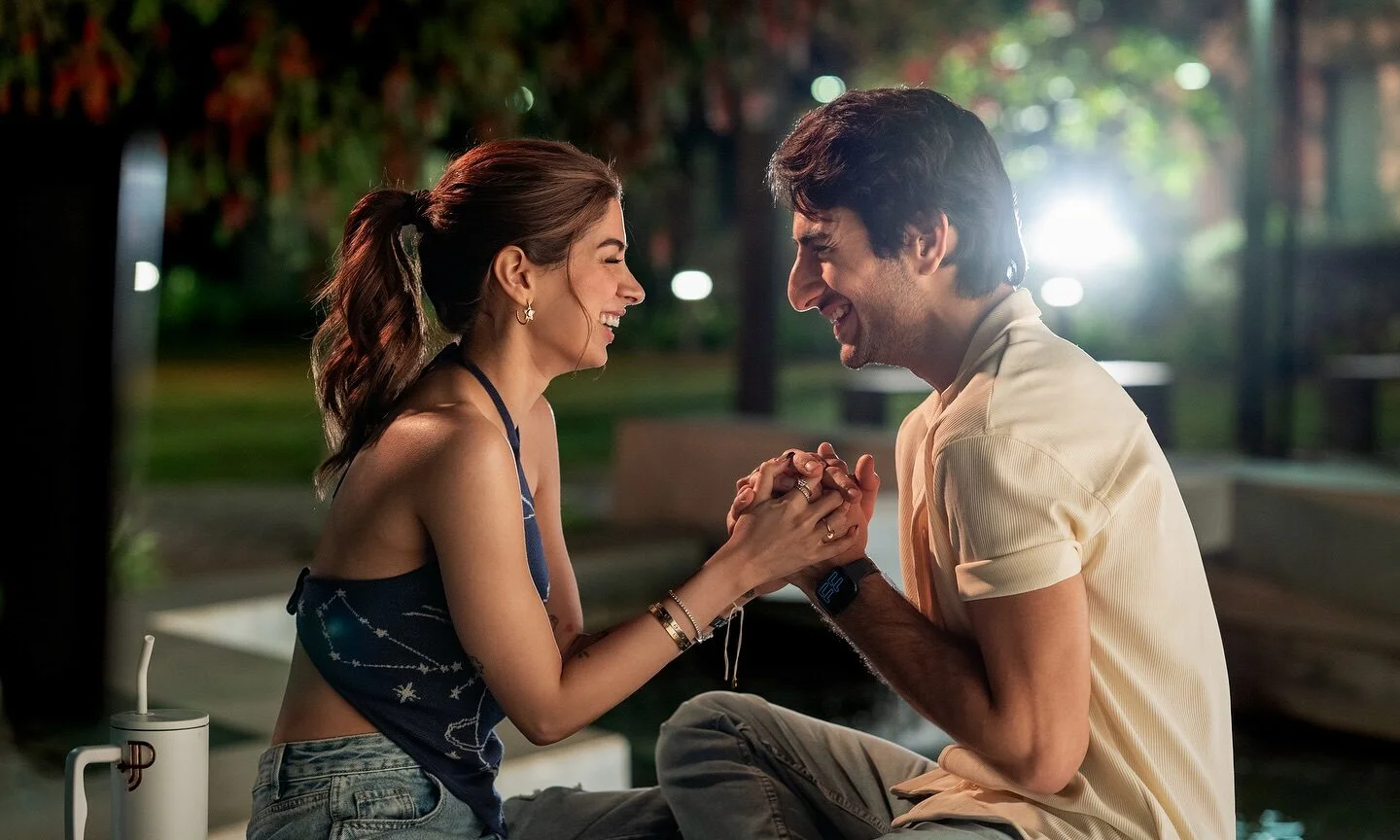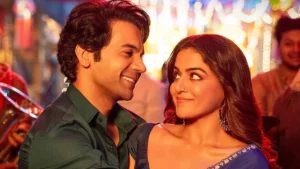
Like every soul engaged in a creative industry, I too have my panic sessions. What happens when AI takes over art? Can emotions be invoked with a prompt? Well, ChatGPT will never know what it’s like to grow up in a dysfunctional family — where every discussion is an audition of India’s Got Latent with crazy gaslighting and minus all the fun. Human stories are messy and no algorithm can cook them up. What AI can probably manage is a film like Nadaaniyan. It looks like someone tried it.
How do they do it? Buy an overpriced AI tool, feed it the right keywords before the trial period ends, and out comes a screenplay with a dated American high school premise and just the right dose of Bollywood nostalgia. Throw in a mega-rich versus regular-rich divide (because the poor can’t afford sparkling water), some career ambitions no one actually cares about, and a token dash of woman empowerment because why not? Of course, no such script is complete without a line that goes, “Tum mere saath flirt kar rahe ho?” And to impress the algorithm, they toss in a dialogue so meta that it hurts: “Main koi AI robot nahi hoon.” And just like that, we get the dream debut of Ibrahim Ali Khan.
Sometimes, I genuinely feel producer Karan Johar is just performing a public service for Bollywood. There’s no way a businessman like him believes Gen-Z cares about star kids. He can’t possibly be that detached from reality. So, a film like Nadaaniyan feels less like a launchpad and more like a cleansing ritual. Why waste resources on two separate disasters when you can just bundle two celebrity children into one film, watch them flail around trying to act, let the audience collectively reject them, and wash your hands off the whole thing? Coming from the man behind some of my favorite films, this is the only explanation I’m ready to accept.
Nadaaniyan is that school group project where everyone’s just happy to be on the attendance sheet. Director Shauna Gautam lands her first gig and spends most of it being starstruck by the holy trinity: Karan Johar, Netflix, and now the Poonawalas. Ibrahim finally gets his soft launch after all those years of walking in and out of the gym just to keep the paparazzi engaged. Khushi, meanwhile, continues her on-the-job training (her own words, not mine. I know this thanks to an interview I wish I hadn’t watched) and improves by about 10% from The Archies. They aren’t good actors. At least not in their current factory settings. But, I’ve found two coping mechanisms to survive them and Nadaaniyan.
One: Close your eyes when Khushi goes full throttle. Her dialogue delivery isn’t a complete disaster — in fact, it’s marginally better than her sister’s, which is hardly a compliment. That little quiver in her voice during emotional scenes reminded me, fleetingly, of her legendary mother. Unfortunately, the actor’s facial muscles fail to move – perhaps due to a reason everyone knows and she acknowledges. It’s tragic because there’s a visible desperation to prove herself, but it’s all trapped inside.
Two: Cover your ears when Ibrahim opens his mouth. Hindi doesn’t come naturally to him. Punchlines soar past their intended targets, and his enunciation can give Siri a complex. There is no hero voice throw to talk about although the texture is suspiciously similar to Ranbir Kapoor’s. That’s not to say he’s any great shakes otherwise — but the lad is quite easy on the eyes. The actor completely stumbles when attempting to play the quintessential Bollywood hero. There’s a moment near the climax where he forces a dramatic facial shiver — the kind Rani Mukerji masterfully delivers in Bombay Talkies upon realizing her husband is gay. If not Ibrahim, I felt secondhand embarrassment for a few seconds. Some might argue, “John Abraham ko kahan acting aati hai, yaar?” Sure, be John Abraham but maybe master the language of your day job first.

Oh wait — did I forget to talk about the story? Don’t worry, so did the makers. Let’s be honest, no one’s watching Nadaaniyan expecting a groundbreaking plot. A tiny sliver of millennials still care about Saif Ali Khan’s family tree, and the writers wrote the script with that specific audience in mind. What do we get? A spin-off-sequel to the godawful Dhadkan. After the recent ad for Nykaa, Archana Puran Singh returns once again as Kuch Kuch Hota Hai’s Ms. Braganza Malhotra. Wait, did Mr. Malhotra (Anupam Kher) die, or did he just escape the mediocrity? Then there’s Jugal Hansraj, now playing a doctor, though judging by his general aura, he’s just as broke as he was in Mohabbatein (at least by this film’s economic standards). Dia Mirza plays his angelic wife because someone has to. She is also a teacher who is classically teacher-type. Together, they form the kind of wholesome family unit that hasn’t existed outside of Bollywood films for decades. Naturally, their son is Ibrahim, because he’s the nicest boy in all of Netflix today. Wait, my middle-class parents would have made my life a living hell if I were to borrow 50 rupees from someone I had known for years. Meanwhile, our guy pockets 50,000 bucks to play pretend boyfriend for some random girl. Also remember, these kids are still in school.
Then we have the Dhadkan duo — Suniel Shetty and Mahima Chaudhry — now locked in a toxic marriage which we saw coming in 2000. Karan, where was a remix of ‘Aksar Is Duniya Mein’ when we badly needed it? Their daughter, played by Khushi, is in desperate need of rescue, and the boy does so after a mandatory, “please meri baat suno, mujhe kuch nahi sunna” routine. Ibrahim, whose character’s name I didn’t bother remembering, is good at everything. Class topper, master debater, national-level swimmer, finance bro – you name it, he excels at it. Naturally, we never see him practice any of these skills, apart from swimming, because how else will he justify the gym scene and shirtless dives?
Watching Ibrahim, I couldn’t help but wonder — just how essential is a six-pack to becoming a star today? Nadaaniyan seizes every possible opportunity to flaunt his torso. In his opening scene, he’s casually hanging out with a group of brats and lifts his shirt mid-conversation to make a point—because apparently, flexing your abs is the new way to win debates. It’s fair to be curious after all, it’s the hormonal age. But Shauna Gautam’s film doesn’t just reflect this shallowness; it accepts it as part of its very DNA.
Nadaaniyan emerges from a rigidly binary thought process. Women wear pink, men wear blue. Girls study fashion design, and boys pursue law. That’s the entire intellectual bandwidth of the film. Maybe the characters should take a quick field trip from Bandra West to Bandra East one afternoon to see just how many women practice law. And let’s not even get started on men in the fashion business — especially in a film produced by Karan Johar. This brand of surface-level empowerment might work if the film was made exclusively for a super-elite social circle of not more than 100 people across Mumbai and Delhi (where the film is conveniently set).
But for the rest of us — the ones watching on a hard-earned Netflix subscription after a long day at work — these stories and characters go straight into the bin. I remember Karan Johar once admitting, during Dharma Productions’ golden era, that he realized Kaal wasn’t a good film because it was a horror movie that didn’t scare him. Well, by that logic, Nadaaniyan is a rom-com that frightens me — not for its story, but for what it says about Dharma’s painful downward spiral and the future of Bollywood itself. At this point, Kaal which starred way better industry kids looks like a Maddock blockbuster. Let that sink in.
Rating: 0 Stars
Nadaaniyan is now streaming on Netflix.


Why only the author has zero star option?